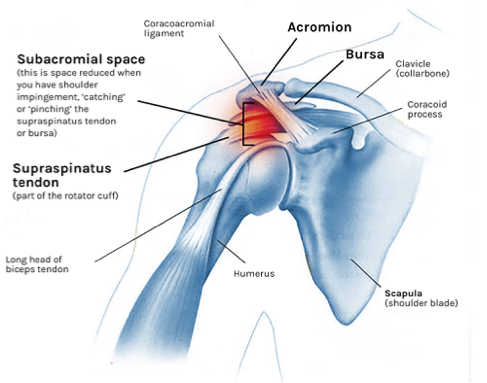The Effect of Posture on Shoulder Pain
Let's face it, many of us have been spending an absurd amount of time working on our computers at home, crouching over our phones, necks jutting forward, shoulders rounded, texting endlessly. The typical home setup is less than ideal. Slumped deep in the couch or contorted in bed, working for hours at a laptop without a break. These twisted and mangled postures have reached an all time high!
How big a role does posture play on shoulder pain?
Studies have shown that posture can in fact play a very big role in the development of shoulder problems. One of the most common causes of shoulder pain is SAIS (subacromial impingement syndrome). This occurs when the rotator cuff tendons (particularly the supraspinatus tendon) will become compressed in the subacromial space. This space is a narrow region where shoulder tendons pass through between the shoulder joint and shoulder blade. Over time this compression leads to shoulder pain, shoulder weakness and shoulder instability.
This affects:
overhead
reaching
lifting motions
makes it difficult to find a comfortable sleeping position
Three of the most common postural abnormalities that contribute to or cause shoulder impingement are:
FHP (forward head posture)
FSP (forward shoulder posture)
Increased kyphosis of the thoracic spine (increased rounding of the mid back)
The muscles that attach to the neck, shoulder, shoulder blade and mid back work together in a perfectly balanced sequence to allow full and pain free range of motion. When there is an imbalance, compensations must occur in an attempt to complete the task.
Understanding the mechanics of posture and shoulder pain.
As you raise your arm up, your mid back prepares for this motion by extending (straightening up) to allow the shoulder blade to rotate upwards in order to complete the arm motion. When you are slumped forward, the overly rounded mid back will already limit the ability of your shoulder blade to rotate upwards and it will compensate by elevating instead in an attempt to help the arm achieve its goal. This elevation puts the blade in an abnormal position, limiting the shoulders range of motion. If your shoulder is sitting too far forward in the socket (from countless hours of reaching to use a mouse, type or text on your phone) it will cause muscles to tighten in the front of your chest and shoulder. If you have forward head posture, it will cause tension and fatigue in the spine and shoulder girdle muscles. These muscles will ultimately pull the blade into an impaired position that directly narrows that crucial subacromial space, which is necessary for the rotator cuff tendon to travel through. As your shoulder reaches upward the space narrows to the point where the surrounding bone starts pinching the tendon, ensuing in pain and thinning and weakening the tendon over time.
A few key points to help reduce the incidence of shoulder impingement that occurs due to postural compromise:
Become aware of the position of your head, spine and dominant shoulder, regularly adjusting their positions until it becomes second nature.
Set up a workstation that makes it easier to maintain good posture. Read more about the best exercises to to improve posture here.
Take frequent breaks to stand, stretch, and move around, it is impossible to hold yourself in perfect posture for so many hours.
Do a few exercises daily to promote muscle balance and get blood flow to the spine and shoulder girdle muscles, especially if you have been sitting for a while. Check out our previous post here for beneficial exercise ideas.
And now the time has come for me to get out of this hunched posture, take a break and get some blood flowing to my neck and shoulder. Perhaps it is time for you to do the same?
Looking for a doctor to address your shoulder pain? Our doctors of physical therapy in Bay Ridge, Brooklyn and NYC are experts in shoulder pain. Contact us for an appointment online here or call 347-560-6920.


